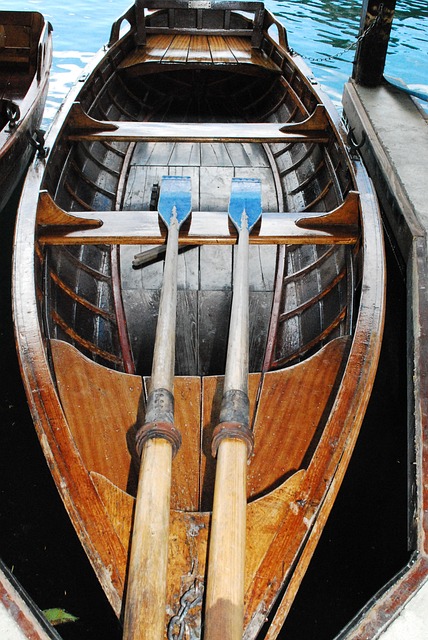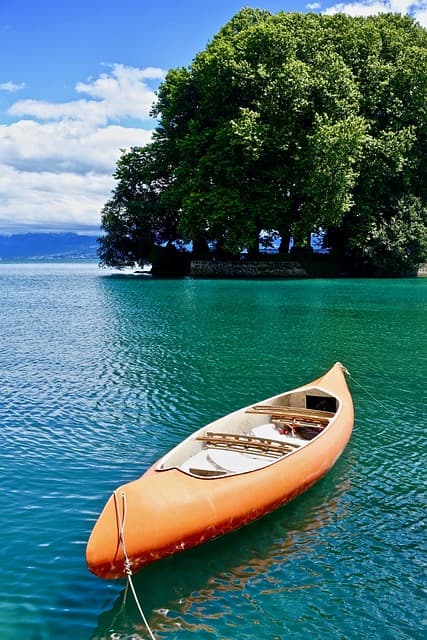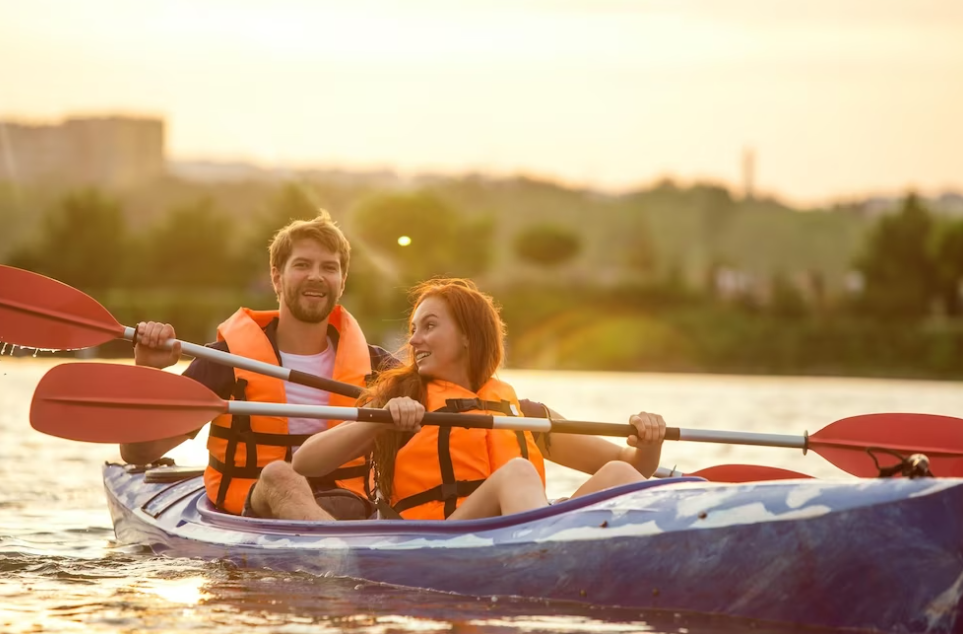Exploring the waters in a tandem kayak offers a delightful avenue for enjoyment. Tandem kayaks often boast a longer, wider, and more stable build compared to single kayaks, making them an excellent choice for newcomers seeking instruction from nearby mentors. If you and your fellow paddler possess some experience, a tandem kayak allows you to cover extensive water expanses efficiently. Regardless of your skill level, the challenge lies in mastering tandem kayak paddling while preserving a harmonious relationship with your partner.
When embarking on the journey of tandem kayak paddling, prioritize compatibility between your capabilities and the kayak and location chosen. Typically, the stern accommodates the stronger paddler, while the bow is for the less experienced. Successful paddling entails the front paddler setting the rhythm, while the rear paddler maintains pace and course alignment. Beyond technique, effective communication and a touch of humor are the keys to a memorable adventure. So, as you delve into tandem kayaking, remember to paddle in sync, steer toward shared goals, and sprinkle in a healthy dose of lightheartedness.
How to Choose Between a Tandem and Solo Kayak
When faced with the decision of choosing between a tandem kayak and a solo kayak, it’s a decision that warrants thoughtful contemplation. Each type of kayak brings its own set of advantages and considerations to the table. Tandem kayaks offer the opportunity for shared experiences and teamwork, making them ideal for paddling with a partner or family member. They can be great for beginners, allowing for assistance and support while learning the ropes of kayaking. On the other hand, solo kayaks provide a sense of independence and solitude on the water, giving you the freedom to explore at your own pace and follow your own route. It’s important to assess your preferences and the kind of experiences you seek before making a choice. Factors like the type of waters you’ll be navigating, the distance you plan to cover, and your comfort level should all be considered. By taking the time to weigh these factors, you can make an informed decision that aligns with your aspirations and helps you avoid potential regrets down the line.
- While solo kayaking is undeniably enjoyable, the allure of double the fun with a tandem kayak may not necessarily hold true. Stories abound of couples who initially relished paddling solo kayaks on rentals but eventually opted for a tandem kayak, envisioning shared weekends on a single vessel. It’s worth noting that solo kayaking provides a sense of complete independence and unbridled freedom on the water. You’re in control of your course and paddle rhythm, enjoying a self-guided experience;
- On the other hand, paddling a tandem kayak presents an entirely different dynamic. It’s a lesson in cooperation and collaboration. Success hinges on your willingness to compromise, relinquish full control, and exhibit patience for each other’s limitations. If this partnership flourishes, tandem kayaking can indeed be immensely enjoyable. However, any relationship frailties might surface as you navigate the waters in somewhat passive-aggressive orbits.
Let it be known that this advice applies to any duo, not solely romantically linked pairs parading their status on social media. Remember, piloting a solo kayak differs markedly from maneuvering a tandem. Choose thoughtfully before making a commitment.
A tandem kayak also serves as an educational vessel for less experienced paddlers. If introducing children to kayaking, a tandem allows vigilant supervision and on-water instruction. Position them at the bow, giving them the responsibility of setting the tempo. Meanwhile, you manage the more challenging task of maintaining a straight course while propelling forward.
Alternatively, if an elderly family member relishes being on water but lacks the physicality to paddle, seating them at the front can provide a delightful day out. Naturally, this necessitates refined technique and considerable strength, as you shoulder all paddling and steering responsibilities throughout the day. Best of luck with that endeavor!
While a single tandem kayak may seem financially pragmatic compared to two separate solo kayaks, remember that the ultimate decision shouldn’t hinge solely on price.
After all, while a tandem kayak might cost less than two solo kayaks, two solos may prove more economical than enduring the fallout of a divorce.
Entering a Tandem Kayak: A Collaborative Approach
To embark on your tandem kayaking adventure, the initial step is boarding the vessel. The technique for entering a tandem kayak shares a remarkable resemblance with the process for solo kayaks, making it a familiar maneuver for those accustomed to kayaking dynamics. For more comprehensive guidance on transitioning in and out of kayaks, you can find my article here.
While many aspects align, there are nuances that distinguish tandem kayak entry from the solo counterpart. A notable advantage is the presence of a partner, offering steadiness and support during the entry process. This collaborative element often renders boarding a tandem kayak even simpler than its solo counterpart.
- The sequence begins with the bow paddler embarking first, facilitated by the stern paddler who diligently maintains the kayak’s stability. Whether it’s the sandy expanse of a beach, the rugged embrace of rocky shores, or the structure of a dock, the stern paddler assumes the role of the anchor, ensuring a secure platform for the bow paddler’s entry;
- Once the bow paddler is settled, the stern paddler, now positioned at the back, prepares to join the voyage. Should the launch point be a beach, a strategic approach involves partially floating the kayak by gently pushing it into the water. This allows the stern paddler to embark with relative ease. Throughout this process, the bow paddler provides essential support, steadying the kayak as much as possible;
- On the other hand, if the entry is from a rocky or docked area, the dynamics remain consistent. The bow paddler’s role in offering stability remains unchanged, while the stern paddler initiates the entry, propelling the kayak away from the shore and into deeper waters.
The symphony of teamwork involved in tandem kayak entry underscores the essence of this shared experience. As you and your partner synchronize your movements, you set the stage for an enjoyable journey on the water. This collaborative boarding process is a testament to the camaraderie that tandem kayaking fosters and the sense of adventure it promises.
Defining the Roles of Bow and Stern Paddlers in Tandem Kayaking
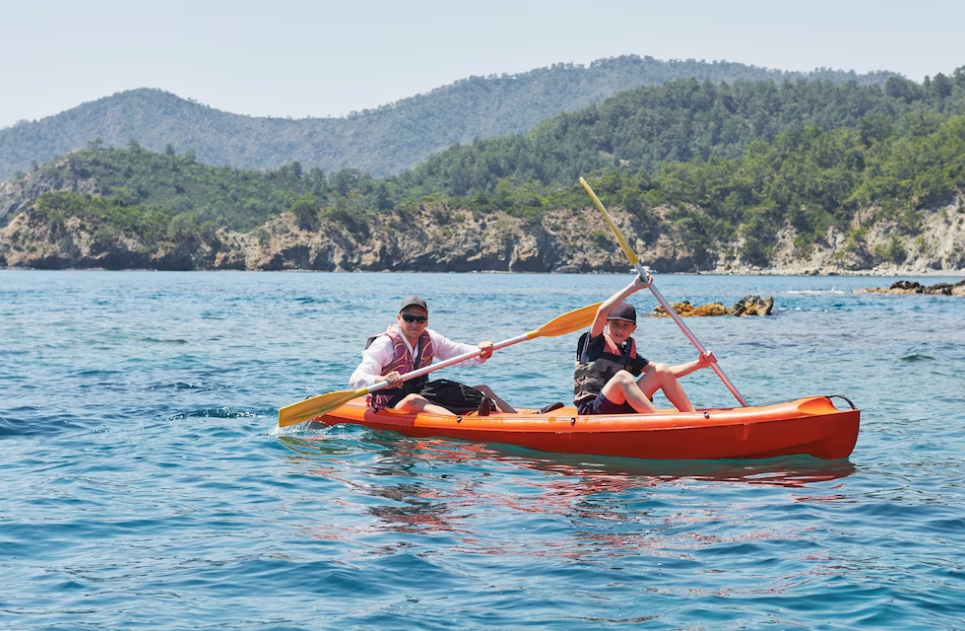
When immersing oneself in the dynamic realm of tandem kayaking, a frequently encountered query surfaces: what distinct roles do the bow and stern paddlers fulfill? This query prompts contemplation and investigation, leading to the revelation that traditional beliefs, both informally expressed and propagated through digital searches, often prescribe a specific division of labor. According to this conventional wisdom, the bow position is typically reserved for the lighter, less experienced paddler, while the stern is claimed by the heavier, more adept counterpart.
This guiding principle indeed holds its merits, its origins deeply rooted in pragmatic considerations that take into account weight distribution and skill levels. Nonetheless, it’s essential to acknowledge that real-world situations frequently unfold in ways that deviate from these prescribed norms. As such, it becomes imperative to embark on an exploration of the intricate interplay between theoretical constructs and practical realities that govern tandem kayaking partnerships. This investigation unveils the subtle nuances and exceptions that contribute to the uniqueness of each pairing, encouraging a deeper understanding of the complex tapestry that weaves together theory and its application.
- The lead paddler establishes the rhythm. Generally, it’s recommended that the paddler positioned at the front of the boat takes charge of setting the pace for paddling. To put it differently, the bow paddler is responsible for dictating the tempo and smoothness of each paddling motion.
Moreover, the front paddler has a role in steering and stabilizing. In instances where a sudden change in direction is needed, the bow paddler can contribute by performing a forward sweep stroke. When this is combined with the stern paddler’s backward sweep stroke on the opposite side, a tandem kayak can swiftly change direction.
An experienced kayaker occupying the front position can also engage in both low and high brace maneuvers whenever they are called for.
Perhaps the front position could potentially be occupied by the paddler with greater strength. When there’s a noticeable difference in skill level between the two paddlers, it can sometimes be logical to position the stronger paddler at the bow.
Learning a new skill is often facilitated by observing and emulating someone who is already proficient. If the front paddler has a weight advantage of 100lb over the stern paddler, it can compromise the boat’s stability. In such a scenario, it’s advisable to place the heavier paddler at the rear. Nonetheless, if the weight difference is not substantial, considering placing the more experienced paddler in the front. This can aid the less experienced paddler in acquiring the techniques of a bow paddler by watching closely. Additionally, it provides the stern paddler with a glimpse of the challenges involved in steering and maneuvering the kayak from the rear.
- The stern paddler adheres to the cadence set by the bow paddler. Conventionally, the more robust and experienced paddler assumes the position at the rear of the kayak. One of the primary responsibilities of the stern paddler is to synchronize with the paddling rhythm of the bow paddler.
There’s no advantage for the stern paddler to attempt raising the paddling cadence from the rear. Paddling a tandem kayak entails conforming to the capabilities of the less experienced paddler. The most efficient approach is to simply match that established cadence.
Steering the kayak also falls under the duties of the stern paddler. Having two individuals attempt to steer a tandem kayak typically leads to considerable difficulties. It’s generally ineffective. The individual positioned at the back of the boat usually takes on the task of maintaining the kayak’s desired direction.
This is best achieved by using corrective paddle strokes that not only propel the boat forward but also gradually refine the course.
On occasion, the stern paddler might need to cease paddling and employ their paddle as a rudder. If you’re the bow paddler, this situation can be frustrating. The rudder introduces a force that challenges the bow paddler’s ability to sustain forward momentum. Corrective paddle strokes tend to maintain a more harmonious paddling partnership compared to relying solely on the paddle rudder.
- Certain tandem kayaks come equipped with rudders. I’ve penned an article discussing the intricacies of utilizing a kayak rudder, which can be found here. Tandem kayaks tend to be lengthy and substantial vessels. Additionally, they carry the weight of two paddlers. Considering these factors, I’ve encountered several paddlers who wouldn’t even consider piloting a tandem kayak unless it was outfitted with a rudder.
The ideal stern paddler embodies a blend of Oprah Winfrey, Dwayne Johnson, and Isaac Newton, in equal thirds. In fact, this amalgamation would be quite an intriguing individual even outside the context of kayaking.
Similar to Oprah, an adept stern paddler possesses the capacity to empathize with the challenges faced by the bow paddler. This individual (the gender choice is random) can defuse tense situations with lighthearted humor and provide constructive feedback that miraculously avoids being interpreted as patronizing. (They might even have the bow paddler retrieve a metaphorical car giveaway ticket from beneath their seat. An Oprah nod.)
With Dwayne Johnson’s mix of muscles and charisma, this paddler can seamlessly apologize for steering errors while also leveraging their strength to rectify significant navigation blunders. Moreover, tandem kayaks can achieve impressive speeds, and someone with a Dwayne Johnson-like approach can help coax out that velocity.
And then there’s Isaac Newton. To considerably downplay his contributions to modern physics, he possessed an acute understanding of angles. This aptitude is highly relevant for the paddler entrusted with guiding a kayak’s course.
Clearly, the composite of traits characterizing a proficient stern paddler should lean towards abundance rather than scarcity, if you intend to enjoy your time on the water with your counterpart seated at the bow.
Mastering Tandem Kayak Paddling: Bringing It All Together
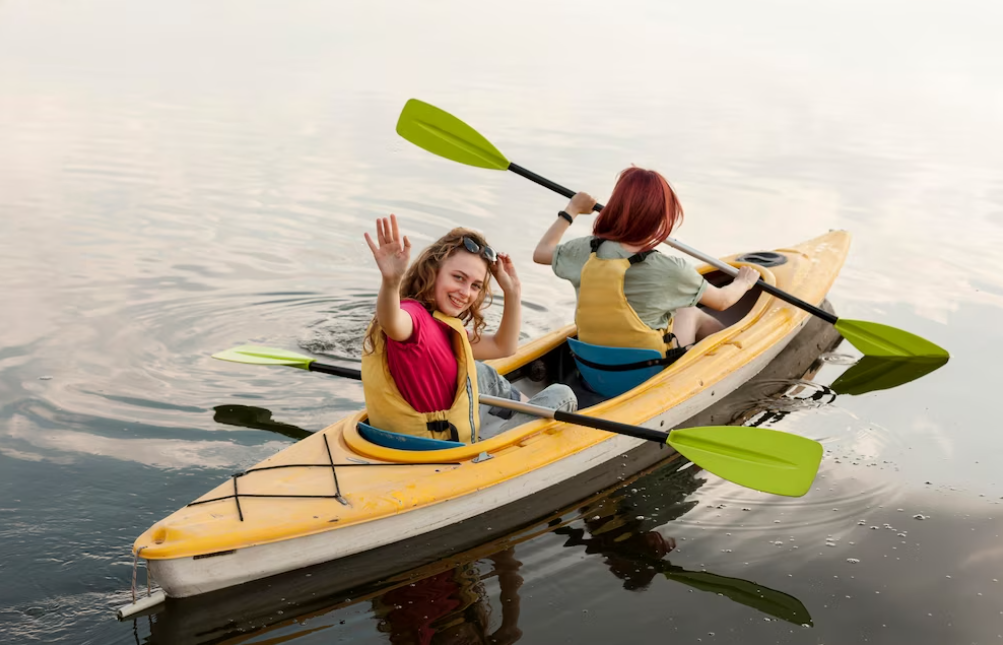
- Paddle together on one side, in rhythm. Tandem kayaking is at its peak efficiency when the bow and stern paddlers synchronize their strokes on the same side and maintain a consistent pace. This approach not only propels your kayak faster but also prevents the all-too-common clash of strokes that arises when two paddlers operate at different rhythms. When both paddlers exert force on the same side simultaneously, your kayak’s hull will naturally tilt from side to side. While complete elimination of this phenomenon is challenging, you can certainly mitigate its impact;
- Opt for abbreviated strokes. When both paddlers opt for shorter strokes, the tendency for the kayak to yaw and fishtail while paddling on the same side will be significantly reduced. If you’re the stern paddler, it’s beneficial to conclude your forward stroke before your paddle blade reaches your hip;
- Adjust your paddle strokes to be more vertical. The advantage of employing vertical paddle strokes lies in the reduction of your kayak’s yaw. However, the trade-off is that vertical strokes tend to be wetter. So, if your goal is to enhance kayak stability, be prepared for a bit more water inside the boat and on your person. It’s a decision for both the bow and stern paddlers to determine the cadence that minimizes the dripping;
- If you’re particularly keen on minimizing water drips, contemplate using paddle drip rings. These rings affix to your paddle shaft to prevent water from flowing along its length and into the kayak. Keep in mind that the effectiveness of drip rings can vary. Some paddlers wholeheartedly endorse them, while others opt to go without. Personally, I haven’t taken a definitive stance on either side of the debate;
- Establish effective communication, maintaining civility. One of the primary benefits of tandem kayaking is the ability to converse with your paddling partner. Nonetheless, achieving this isn’t always as straightforward as it might seem;
- Bow paddlers, adjust your communication approach. Since the stern paddler is oriented towards the front, while you’re also facing forward, communication can be challenging on windy days with rough waters. To address this, bow paddlers should turn their heads to the side when talking to their partner;
- Bow paddlers, embrace your role as the kayak’s eyes. Given your position at the front, you’re responsible for identifying obstacles that the stern paddler might miss and providing steering instructions to the rear. Wondering how to carry this out effectively? If this question is serious, refer back to the previous tip and read it with extra attention.
Conclusion
Embarking on tandem kayaking offers a delightful way to share moments with a friend or loved one (who’s to say they can’t be both?). Bear in mind, however, that tandem kayaking differs significantly from solo kayaking. It’s wise to either rent or give a tandem boat a trial run before committing to it as a permanent addition to your aquatic adventures.
As you and your partner familiarize yourselves with your respective roles and refine your abilities (which encompass effective communication and compromise), you’ll anticipate numerous joyful years of tandem kayaking. Alternatively, you might eagerly anticipate years of solo kayaking, recognizing that you sidestepped a potential hiccup by avoiding the purchase of a tandem (you did refrain from buying one, didn’t you?).
Either way, it’s a win-win situation. Hooray!
